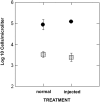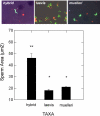Sterility and gene expression in hybrid males of Xenopus laevis and X. muelleri
- PMID: 17712429
- PMCID: PMC1940320
- DOI: 10.1371/journal.pone.0000781
Sterility and gene expression in hybrid males of Xenopus laevis and X. muelleri
Abstract
Background: Reproductive isolation is a defining characteristic of populations that represent unique biological species, yet we know very little about the gene expression basis for reproductive isolation. The advent of powerful molecular biology tools provides the ability to identify genes involved in reproductive isolation and focuses attention on the molecular mechanisms that separate biological species. Herein we quantify the sterility pattern of hybrid males in African Clawed Frogs (Xenopus) and apply microarray analysis of the expression pattern found in testes to identify genes that are misexpressed in hybrid males relative to their two parental species (Xenopus laevis and X. muelleri).
Methodology/principal findings: Phenotypic characteristics of spermatogenesis in sterile male hybrids (X. laevis x X. muelleri) were examined using a novel sperm assay that allowed quantification of live, dead, and undifferentiated sperm cells, the number of motile vs. immotile sperm, and sperm morphology. Hybrids exhibited a dramatically lower abundance of mature sperm relative to the parental species. Hybrid spermatozoa were larger in size and accompanied by numerous undifferentiated sperm cells. Microarray analysis of gene expression in testes was combined with a correction for sequence divergence derived from genomic hybridizations to identify candidate genes involved in the sterility phenotype. Analysis of the transcriptome revealed a striking asymmetric pattern of misexpression. There were only about 140 genes misexpressed in hybrids compared to X. laevis but nearly 4,000 genes misexpressed in hybrids compared to X. muelleri.
Conclusions/significance: Our results provide an important correlation between phenotypic characteristics of sperm and gene expression in sterile hybrid males. The broad pattern of gene misexpression suggests intriguing mechanisms creating the dominance pattern of the X. laevis genome in hybrids. These findings significantly contribute to growing evidence for allelic dominance in hybrids and have implications for the mechanism of species differentiation at the transcriptome level.
Conflict of interest statement
Figures







Similar articles
-
Gene expression analysis of the ovary of hybrid females of Xenopus laevis and X. muelleri.BMC Evol Biol. 2008 Mar 10;8:82. doi: 10.1186/1471-2148-8-82. BMC Evol Biol. 2008. PMID: 18331635 Free PMC article.
-
Hybrid sterility and evolution in Hawaiian Drosophila: differential gene and allele-specific expression analysis of backcross males.Heredity (Edinb). 2016 Aug;117(2):100-8. doi: 10.1038/hdy.2016.31. Epub 2016 May 25. Heredity (Edinb). 2016. PMID: 27220308 Free PMC article.
-
Testis-derived microRNA profiles of African clawed frogs (Xenopus) and their sterile hybrids.Genomics. 2008 Feb;91(2):158-64. doi: 10.1016/j.ygeno.2007.10.013. Genomics. 2008. PMID: 18079091
-
Sperm fate and function in reproductive isolation in Drosophila.Soc Reprod Fertil Suppl. 2007;65:155-73. Soc Reprod Fertil Suppl. 2007. PMID: 17644960 Review.
-
Misregulation of Gene Expression and Sterility in Interspecies Hybrids: Causal Links and Alternative Hypotheses.J Mol Evol. 2016 May;82(4-5):176-82. doi: 10.1007/s00239-016-9734-z. Epub 2016 Mar 29. J Mol Evol. 2016. PMID: 27025762 Review.
Cited by
-
The diverse effects of phenotypic dominance on hybrid fitness.Evolution. 2022 Dec;76(12):2846-2863. doi: 10.1111/evo.14645. Epub 2022 Oct 27. Evolution. 2022. PMID: 36221216 Free PMC article.
-
Rampant Misexpression in a Mimulus (Monkeyflower) Introgression Line Caused by Hybrid Sterility, Not Regulatory Divergence.Mol Biol Evol. 2020 Jul 1;37(7):2084-2098. doi: 10.1093/molbev/msaa071. Mol Biol Evol. 2020. PMID: 32196085 Free PMC article.
-
Hybrid male sterility between Drosophila willistoni species is caused by male failure to transfer sperm during copulation.BMC Evol Biol. 2015 May 1;15:75. doi: 10.1186/s12862-015-0355-8. BMC Evol Biol. 2015. PMID: 25925738 Free PMC article.
-
Facilitation of environmental adaptation and evolution by epigenetic phenotype variation: insights from clonal, invasive, polyploid, and domesticated animals.Environ Epigenet. 2017 Mar 29;3(1):dvx002. doi: 10.1093/eep/dvx002. eCollection 2017 Jan. Environ Epigenet. 2017. PMID: 29492304 Free PMC article. Review.
-
Empirical evidence for large X-effects in animals with undifferentiated sex chromosomes.Sci Rep. 2016 Feb 12;6:21029. doi: 10.1038/srep21029. Sci Rep. 2016. PMID: 26868373 Free PMC article.
References
-
- Haldane JBS. Sex ratio and unisexual sterility in animal hybrids. J Genet. 1922;12:101–109.
-
- Michalak P, Noor MAF. Genome-wide patterns of expression in Drosophila pure species and hybrid males. Mol Biol Evol. 2003;20:1070–1076. - PubMed
-
- Barbash DA, Lorigan JG. Lethality in Drosophila melanogaster/Drosophila simulans species hybrids is not associated with substantial transcriptional misregulation. J Exp Zool (Mol Dev Evol) 2006;306B - PubMed
Publication types
MeSH terms
Substances
LinkOut - more resources
Full Text Sources
Medical
Molecular Biology Databases

